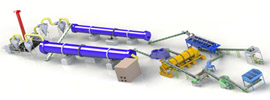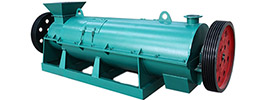Stirring-Tooth Granulator: An Efficient and Flexible Solution for Organic Waste Granulation
1. Core Definition and Working Principle
A stirring-tooth granulator is an industrial machine that achieves granulation of powdery or wet materials through mechanical stirring, shearing, and rolling. Its key components include:
- Rotating drum: Inclined or horizontally placed, it rotates uniformly to drive material movement inside.
- Stirring-tooth assembly: Spiral or paddle-shaped teeth fixed on the drum’s inner wall or central shaft, providing intense stirring, extrusion, and cutting of materials.
- Drive system: A motor and gearbox power the drum and stirring teeth, controlling rotational speed and torque output.
- Liquid spray system (optional): Sprays binders or moisture to aid granule formation.
- Discharge port and screen: Separates qualified granules; undersized or oversized particles are recycled for re-granulation.
Working Principle:
- Pre-processed material (20%–50% moisture content) enters the drum, where stirring teeth distribute it evenly and initiate agglomeration.
- Extrusion and kneading: Wet materials form tiny granule “cores” under mechanical pressure, with capillary forces and binder-enhanced adhesion between particles.
- Rolling and polishing: As the drum rotates, granules roll along the inner wall under centrifugal force, coating with fine powder to grow to target size.
- Screening and discharge: Qualified granules pass through the screen, while oversized/undersized ones return for reprocessing.
2. Technical Advantages and Performance Features
- Broad material adaptability
- Handles wet materials (20%–50% moisture) without additional drying or crushing steps.
- Suitable for raw materials with particle sizes ≤5 mm, including high-fiber and high-moisture feedstocks (e.g., livestock manure, straw, sludge).
- High granulation efficiency and quality
- Produces strong, crush-resistant granules with excellent sphericity (≥0.7), smooth surfaces, and high bulk density.
- Achieves ≥90% granulation rate, with particle diameters adjustable (typically 2–8 mm) via stirring-tooth angle, rotational speed, or moisture content.
- Low energy consumption and high productivity
- Consumes 30%–50% less energy than pan or extrusion granulators, ideal for continuous production.
- Intermittent stirring prevents excessive granule adhesion, ensuring uniformity and minimizing rework.
- Operational flexibility and adjustability
- Dynamic matching of rotational speed and stirring intensity avoids under- or over-granulation.
- Customizable designs (e.g., Φ1000–Φ1800 models) cater to varying capacity demands.
- Robust construction and easy maintenance
- Reinforced seamless steel drum and stable base ensure long service life and smooth operation.
- Regular cleaning of stirring teeth and the drum prevents clogging, with low maintenance costs.
3. Applications and Typical Use Cases
- Organic fertilizer production
- Raw material processing: Livestock manure (chicken, cattle, pig), straw, sludge, brewer’s grains, and soybean residue are granulated after fermentation.
- Product types: Bio-organic fertilizers, organic-inorganic compound fertilizers, and microbial inoculants.
- Case study: Zhengzhou Xiangtai Heavy Industry’s stirring-tooth granulator supports 10,000-ton/year organic fertilizer lines, delivering high granulation rates and strength.
- Chemical and environmental sectors
- Fine powder granulation: Peat, lignite, sugar mill filter mud, and papermaking sludge are pelletized into spherical forms.
- Sludge resource recovery: Municipal sludge granules are repurposed for soil amendment or fuel production.
- Agricultural waste utilization
- Straw and food waste: Converted into granular fuel or organic fertilizers, addressing challenges in processing high-fiber materials with traditional methods.
4. User Feedback and Industry Evaluation
- Granule quality: Users report uniform, high-strength granules with ≥95% pass rates after screening, cutting labor costs for manual sorting.
- Operational ease: Compact design allows real-time adjustments to rotational speed and feed rate, adapting to varying material conditions.
- Durability: Reinforced steel construction and stable bases extend equipment lifespan to 5–8 years, with failure rates below 5%.
Conclusion: The stirring-tooth granulator stands out for its versatility, high granulation efficiency, and energy savings, making it indispensable in organic fertilizer production, chemical granulation, and agricultural waste recycling. As environmental regulations tighten and organic farming expands, demand for these machines will rise, driving innovations in intelligent control and ultra-efficient material processing.
 Send us a Email
Send us a Email Wulong Industrial Cluster
Wulong Industrial Cluster Have any question?
Have any question?



















